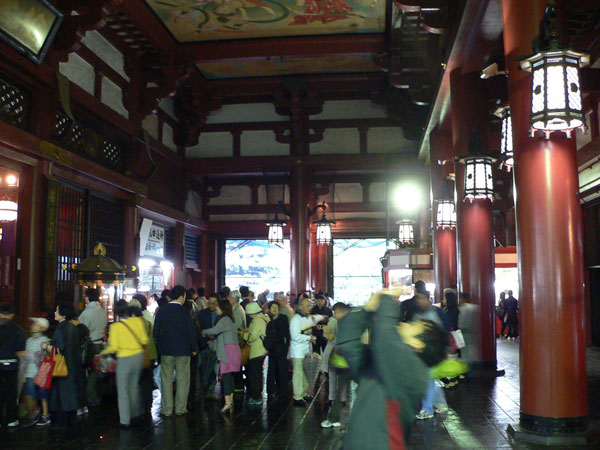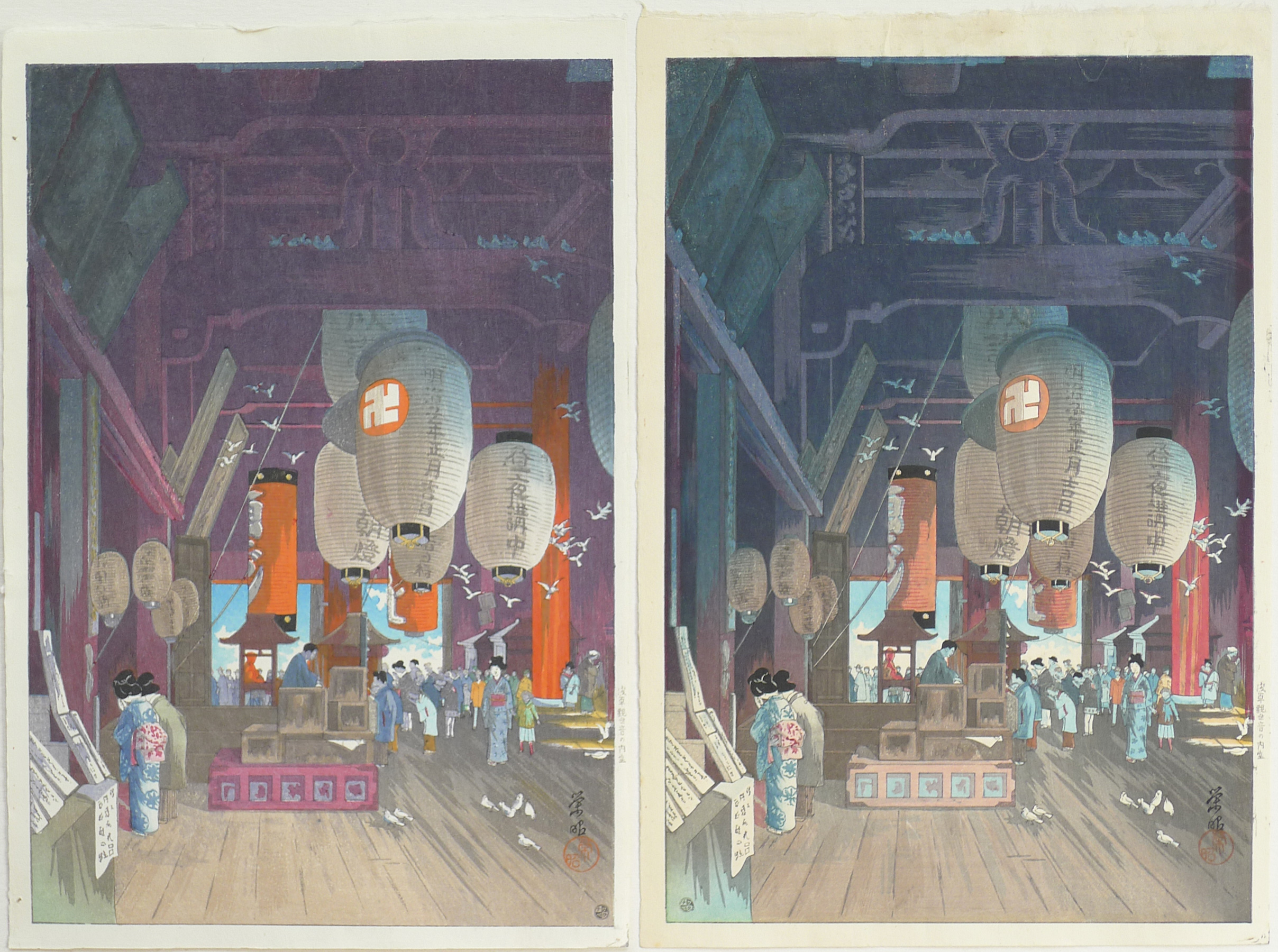About This Print
Source: Shin-Hanga: New Prints in Modern Japan, Kendall Brown, Hollis Goodall-Cristante, Los Angeles County Museum of Art, 1996, p. 83, figure 113, cat. no. 93.Inside Asakusa Kannon Temple nicely captures the atmosphere within this venerable Tokyo landmark, where the hum of voices, clink of coins thrown into the offering box, and flutter of pigeons in the rafters reverberate off the dusty wooden floor. This cacophony is paralleled by the visual confusion of colorful kimonos, flying birds, huge lanterns, and votive paintings, all competing for space in the half-lit interior. While shin hanga prints of Tokyo usually avoid crowd scenes to find beauty in the empty stillness of the city, Narazaki’s depiction of visitors at a famous temple provides a noteworthy exception.
Both these prints carry the round 6mm seal of Watanabe publishing (lower right corner on #230A and lower left corner on #230) but they show numerous subtle differences introduced during the printing process. It is likely that print #230 is an earlier printing as some of its lines look crisper than 230A. As always, clicking on the above images will provide an enlargement allowing you to make your own comparison between the two printings.
Asakusa Kannon Temple
Source: University of Alberta Museum website http://www.museums.ualberta.ca/art/details.aspx?key=15995&r=9&t=1The Asakusa Kannon Temple (also known as Sensoji Temple) is Tokyo's largest and oldest Buddhist temple and a significant tourist attraction. Legend says that in the year 628, two brothers fished a statue of Kannon, the goddess of mercy, out of the Sumida River, and even though they put the statue back into the river, it always returned to them. When approaching the temple, visitors first enter through the Kaminarimon (Thunder Gate), the outer gate of the Sensoji and symbol of Asakusa which is marked by a 10 foot high paper lantern. The temple has been destroyed and rebuilt numerous times and is a significant part of Japanese and Buddhist heritage. Lanterns occupy much of the area of the Sensoji temple and are often imprinted with names of families, Buddhist blessings, well wishes and even swastika's. The swastika, while having a negative Western connotation, is a sacred Buddhist symbol (occurring throughout history as early as the Paleolithic age and in many different cultures) often signifying balance or universal harmony and re-creation or infinity.
Source: Los Angeles County Museum of Art website - Exhibition Wall Label from Japanese Prints: Edo/Tokyo http://collectionsonline.lacma.org/mwebcgi/mweb.exe?request=record;id=103602;type=101
Located in the north eastern outskirts of Edo, on the road to the Yoshiwara, Asakusa abounded with temples to guard the unlucky north east quadrant of the city, that direction being considered a source of evil. Among these temples, the Asakusa Kannon temple was in close enough proximity to the Yoshiwara ("pleasure quarter", that convenient “rest stops”, including tea houses, dining and shopping places, for the latter’s customers were built in adjacent areas. As such, Asakusa became linked in the public’s mind with the Yoshiwara. The temple itself is famous for its grand-scale red lanterns, which artists have featured repeatedly in prints since the early 1800s.

Print Details
| IHL Catalog | #230 and #230A |
| Title | Inside Asakusa Kannon Temple (Asakusa Kanzeon no naidô) |
| Series | |
| Artist | Narazaki Eishō (1864-1936) |
| Signature | Eishō |
| Seal | Eishō |
| Publication Date | March 1932 |
| Edition | Later editions published between 1946-1957 with publisher's 6mm round type-A seal in lower left corner on #230 and lower right corner on #230A. |
| Publisher | Watanabe Shōzaburō |
| Printer | |
| Impression | excellent |
| Colors | excellent |
| Condition | #230: good - mounting residue from original folio verso top margin center; mounting residue front top margin; 1/4" x 1/2" sticker remnant verso; slight overall toning #230A: excellent - two print drying holes left margin |
| Miscellaneous | |
| Genre | shin hanga (new prints) |
| Format | Oban tate-e |
| H x W Paper | #230: 15 1/2 x 10 3/8 in. (39.8 x 26.4 cm) #230A 15 1/4 x 10 1/4 in. (38.7 x 26 cm) |
| H x W Image | #230: 14 1/4 x 9 5/8 in. (36.2 x 24.4 cm) #230A: 14 1/4 x 9 5/8 in. (36.2 x 24.4 cm) |
| Collections This Print | Los Angeles County Museum of Art M.73.37.525 (Watanabe black circular seal, likely 6mm, bottom right of image); University of Iowa. Museum of Art and 1968_233 (Watanabe black circular seal, likely 6mm, bottom right of image); Museum of Fine Arts Boston 50.2848 (Watanabe black circular seal, likely 6mm, bottom right of image); Carnegie Museum of Art 89.28.1088 (with Watanabe D-type seal); University of Alberta Art Collection 2001.6.21 (unknown edition); Yale University Art Gallery 1969.31.36 (with Watanabe D-type seal) |
| Reference Literature | Shin-Hanga: New Prints inModern Japan, Kendall Brown, Hollis Goodall-Cristante, Los Angeles County Museum of Art, 1996, p. 83, Fig. 113; Japanese Wood-block Prints, Shizuya Fujikake, Japan Travel Bureau, 1938, p. 94, 95; The Legacy of Japanese Printmaking, Barry Till, Art Gallery of Greater Victoria, 1986, plate 62; Modern Japanese Prints: The Twentieth Century, Amanda T. Zehnder, Carnegie Museum of Art, 2009, p. 132; Hanga ni miru Tokyo no fukei; Kanto daishinsai kara senzen made, Ota Kuritsu Kyodo Hakubutsukan, 2002, pl. 213, p. 50. |


